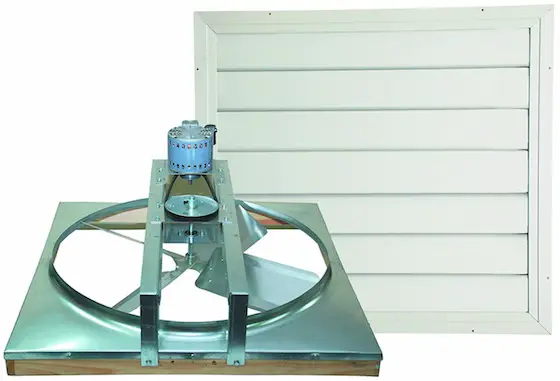Table Of Content

For more great ways to cool your home, check out our picks for the best pedestal fans, oscillating fans, and tower fans. As well, many homeowners are choosing to install an Advanced Whole House Fan if their A/C breaks and are in need of A/C repair. It is always best to start on high speed, and as the temperature in your house begins to drop, you can lower the speed of the fan. There are four main types of whole-house fans, and they differ in several ways.
Pick #1. QuietCool Energy Saver
Designed to cover up to 3,462 square feet of space, this fan can result in major electricity savings for the right home. Depending on the size of the Advanced Whole House Fan you are installing, you can expect to pay between $500 to $3000 installed. The pricing varies based on the type of whole house fan, the sizing requirements, and the motor type. An Advanced Whole House Fan can cool your home, just like an air conditioning system, but in a completely different way. A/C systems work well but is much more expensive to install and is the single most expensive appliance to run in your home causing higher energy bills during the warmer months of the year. The humidity level is usually high in the early morning and drops down to its lowest point in the late afternoon.
Experience a More Comfortable Way to Live
Beyond this one-time product cost, you’ll also enjoy lower monthly utility bills. There’s nothing worse than coming home from a long day to a hot and stuffy house. Yet here in Southern California, many homeowners are familiar with this uncomfortable reality. Thankfully, there is an effective way to cool down your house other than installing an expensive central air conditioning system. Once you’ve cut out your opening, you’ll be installing your whole house fan in your attic, and will hang the motor head and the acoustic insulated flexible ducting from the rafters. You’ll fasten the unit using metal straps preinstalled on the motor head for your convenience.
How Much Does a Whole House Fan Cost?
Better engineered new whole house fans take care of these problems in multiple ways. Make sure to have a balance of intake and exhaust avenues to properly ventilate your home. In the attic, remember that the the amount of intake limits the flow of air. With a balanced ventilation system, exhaust vents in the upper portion of your attic provide half of it, while intake vents provide the other half.
Can a Whole-House Fan Keep Your Whole Family Cool?
Each manufacturer will have it’s specific recommendations for maximum attic size or home size. These house exhaust fans are pricier than standard or insulated whole-house fans. However, In-Line house fans offer a small damper that is less obtrusive to look at than large whole-house fans and much easier to install. Limited to 1,000 – 1,800 CFM, however, the insulated whole-house fans will take 3-4 times longer to cycle the air volume of your interior than a standard whole-house fan. We think Whole House fans are worth the cost of installing in any home, as long as the Correct Type is installed to match the size of your home and climate for your region.

To add up your attic venting, you will have to go into your attic, and estimate the sizes of your ridge vent, gable vents, and any passive vents. A high quality whole house fan can reduce your air conditioning costs during hot weather anywhere from 25% and all the way up to 90%. With some homes, all that is needed is to run the fan for 30min up to an hour. Some owners like to keep the whole house fan on because it creates a small breezy feeling in the home. Whole house fans work by using fan suction, creating a negative pressure environment in the home, and putting positive pressure in the attic. Put simply, the fan sucks out the hot air from the interior and pushes it outside through the attic vents.
Best for Smaller Spaces
During hotter months, nighttime is actually the best time to run a whole-house fan. You can also install a timer or a Wi-Fi switch if you’d prefer to schedule when the fan runs. There is a lot to think about when shopping for the best whole-house fan, but choosing one needn’t be complicated or time-consuming. Those in the market for one of these fans will want to consider the following top picks, which are among the best whole-house fans on the market. Whether hunting for a ducted fan or a more basic model, you’ll be sure to find some good options for everyone among these leading products.
If you choose a high-speed fan, you need to make sure there’s enough attic venting to expel its output. A good rule of thumb is 1 square foot of venting area for every 750 CFM of fan. Or you can simply provide the same amount of attic venting as the size of the shutter hole in the ceiling. • In winter months, whole house fans could present energy loss as heated room air leaks into the attic.
Average Ceiling Fan Installation Cost In 2024 – Forbes Home - Forbes
Average Ceiling Fan Installation Cost In 2024 – Forbes Home.
Posted: Mon, 26 Feb 2024 08:00:00 GMT [source]
A control kit can allow you to adjust the fan from anywhere in your home, although you’ll need to purchase it separately. The powder-coated finish of this fan helps it stand up to weather corrosion issues, and combined with its steel motor struts, make this an especially durable model. This solid construction gives this fan a nice sturdy feel, and reduces the chances of rattling or squeaking during use. Its direct-drive design contributes to its quiet operation, and by using four blades instead of the usual three, increases its productivity. The large insulated doors on this ductless fan, which automatically close shut when the fan is not in use, are a big reason why we chose it for this list.
In addition to lowering utility bills of new homeowners, this also helps to significantly reduce the strain on limited energy supplies throughout these zones of California. Get at least 3 bids in writing for the work to be performed before you choose an installer. Be sure your installer has the proper licenses (if required) and is fully insured with workers comp and liability insurance. Make sure there are no complaints against the installer filed with your local consumer affairs office. Whole house fan installation really is fast and easy for any tradesperson, handyman or even a handy homeowner. Watch our video and find out how cool installing a whole house fan can be (no pun Whole House Fan Installation Is Fast and Easy.
Just multiply the square footage of your home by 2-3 to figure out how many CFM (airflow) and QC fans you need to buy. Also, if there aren’t enough CFM, the fan might not make enough breeze, which is needed to cool the house, attic, and skin temperature quickly. A whole house fan is a valuable cooling option that can significantly reduce the reliance on air conditioning and save on energy costs. By harnessing the power of natural ventilation, it provides a refreshing and energy-efficient way to cool down your home. While it may not be suitable for all climates and households, those living in regions with cooler evenings can reap the benefits of this eco-friendly and cost-effective cooling solution.
These super quiet whole house fans are hung on the attic rafters away from the ceiling. This allows for an ultra quiet whole house fan and avoids the biggest complaint which is noise. Other fans will have to be wired to a wall switch with two separate switches.
Many models have built-in timers or temperature switches that can be programmed to turn on automatically. QuietCool’s ES-4700 might cost more than the company’s other units, but this series’ brushless direct-drive motors are efficient, quiet, and require minimal maintenance. A variant of traditional whole house fans are models with insulated doors. The doors or dampers of this fan automatically open and close automatically when the fan is in use.

No comments:
Post a Comment